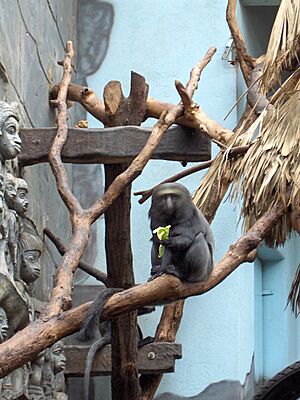Hamlyn's monkey facts for kids
Quick facts for kids Hamlyn's monkey |
|
|---|---|
 |
|
| Conservation status | |
| Scientific classification | |
| Genus: |
Cercopithecus
|
| Species: |
hamlyni
|
 |
|
| Geographic range | |
The Hamlyn's monkey, also called the owl-faced monkey, is a type of Old World monkey. It lives in the bamboo and rainforests of the Congo. This monkey is very rare, so scientists don't know much about it. It is found across eastern Congo, from the Epulu River to the Lukuga River. You can also find it from the Congo River to the Kabale Forest, and sometimes in northwestern Rwanda.
Hamlyn's monkeys often travel on the ground. Some researchers believe they might be more active at night.
What Do They Look Like?
Hamlyn's monkeys are usually dark gray. They have a special white stripe that goes from their nose to their upper lip. This stripe makes them look a bit like an owl, which is why they are called "owl-faced monkeys."
Baby Hamlyn's monkeys look different from adults. They have a yellow-brown coat and a pink face. Adult males are much bigger than females. Males usually weigh between 7 to 10 kilograms (about 15 to 22 pounds). Females are smaller, weighing about 4.5 to 6 kilograms (about 10 to 13 pounds).
These monkeys have special scent glands on their chest. They use these glands to mark their territory. This tells other animals that the area is already claimed.
Where Do They Live?
Hamlyn's monkeys live in the high parts of forests. They are found at elevations above 900 meters (about 3,000 feet). Some have even been seen as high as 4,600 meters (about 15,000 feet). They prefer bamboo forests and thick rainforests. Their home range is mostly in the eastern part of the Democratic Republic of Congo.
What Do They Eat?
Scientists believe that Hamlyn's monkeys eat mostly fruits and leaves. This type of diet is called frugivore-folivore. They travel over a wide area each day, mostly searching for food.
Family Life
Hamlyn's monkeys usually live in small groups. These groups have ten members or fewer. A typical group includes one male and several females. There is no evidence that they live in pairs (one male and one female).
Cool Facts!
The name "Hamlyn's monkey" comes from an animal dealer. He was the first person to bring this monkey species to the London Zoo. In zoos, Hamlyn's monkeys have been known to live for about 33 years.
There are two known types, or subspecies, of Hamlyn's monkey:
- Cercopithecus hamlyni hamlyni
- Cercopithecus hamlyni kahuziensis


